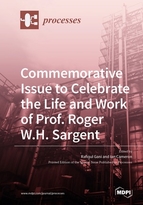Commemorative Issue to Celebrate the Life and Work of Prof. Roger W.H. Sargent
A special issue of Processes (ISSN 2227-9717).
Deadline for manuscript submissions: closed (31 May 2019) | Viewed by 54322
Special Issue Editors
Interests: energy-efficient; sustainable process synthesis; design and intensification; chemical product synthesis and design; modelling of properties of chemicals and their mixtures; development of computer-aided; model-based tools for product–process synthesis
Interests: process systems engineering; granulation; risk management; intelligent systems and engineering education
Special Issue Information
Dear Colleagues,
In 2019, Processes will be publishing a Special Issue to commemorate the life, work, and impact of Professor Roger W.H. Sargent. Professor Sargent worked at Imperial College London for almost 60 years and is widely regarded as the ‘academic father’ of Process Systems Engineering (PSE).
Professor Sargent’s impacts have been global. He leaves an immense legacy of many Imperial College PhD graduates and subsequent generations of researchers who in turn have contributed to the expansion of PSE as an influential area within higher education programs, as well as driving industry innovations and performance.
This Special Issue seeks to honour Professor Sargent’s legacy through insightful technical contributions, as well as through personal reflections of the authors on his impact on their own perspectives, thinking, and practice.
The editors ask interested authors to confirm their intention to submit a manuscript by 1st November 2018. The deadline for submission of the manuscript is 31 May 2019.
The Special Issue will be edited by Professors Rafiqul Gani (rgani2018@gmail.com) and Ian Cameron (i.cameron@uq.edu.au).
Prof. Dr. Rafiqul Gani
Prof. Dr. Ian Cameron
Guest Editors
Manuscript Submission Information
Manuscripts should be submitted online at www.mdpi.com by registering and logging in to this website. Once you are registered, click here to go to the submission form. Manuscripts can be submitted until the deadline. All submissions that pass pre-check are peer-reviewed. Accepted papers will be published continuously in the journal (as soon as accepted) and will be listed together on the special issue website. Research articles, review articles as well as short communications are invited. For planned papers, a title and short abstract (about 100 words) can be sent to the Editorial Office for announcement on this website.
Submitted manuscripts should not have been published previously, nor be under consideration for publication elsewhere (except conference proceedings papers). All manuscripts are thoroughly refereed through a single-blind peer-review process. A guide for authors and other relevant information for submission of manuscripts is available on the Instructions for Authors page. Processes is an international peer-reviewed open access monthly journal published by MDPI.
Please visit the Instructions for Authors page before submitting a manuscript. The Article Processing Charge (APC) for publication in this open access journal is 2400 CHF (Swiss Francs). Submitted papers should be well formatted and use good English. Authors may use MDPI's English editing service prior to publication or during author revisions.







